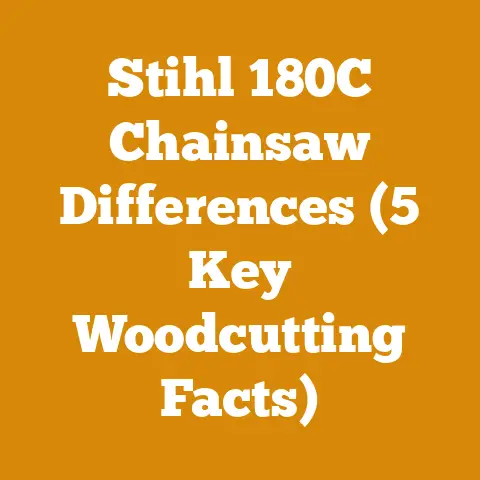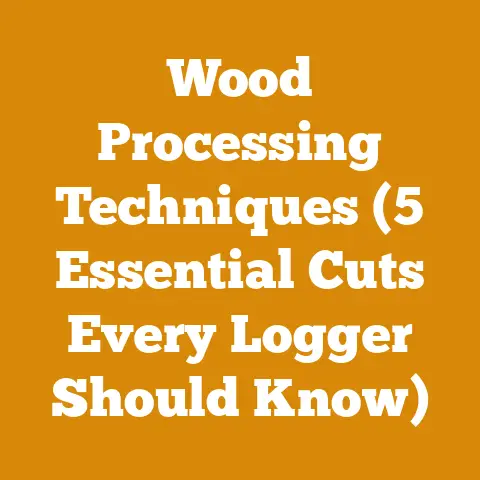2 in 1 Stihl Chainsaw Sharpener (Easyfile Tips for Perfect Cuts)
Ever wrestled with a chainsaw that just wouldn’t bite, leaving you with frustratingly rough cuts and a whole lot of wasted effort? I know I have. That’s why the “2 in 1 Stihl Chainsaw Sharpener (Easyfile Tips for Perfect Cuts)” caught my eye. It promises a solution to a problem every chainsaw user faces: maintaining a sharp chain for optimal performance.
But what does that promise really entail? Is it a worthwhile investment, or just another gadget destined to gather dust in the shed? Let’s dive deep into the world of chainsaw sharpening, specifically focusing on this Stihl offering, and explore how it can help you achieve “perfect cuts.”
The Quest for the Perfect Cut: Why Chainsaw Sharpening Matters
Before we dissect the Stihl 2-in-1 sharpener, it’s crucial to understand why chainsaw sharpening is so vital. It’s not just about making the job easier; it’s about safety, efficiency, and the longevity of your chainsaw.
- Safety First: A dull chain forces you to apply more pressure, increasing the risk of kickback – a dangerous situation where the chainsaw suddenly jumps back towards you. A sharp chain bites into the wood smoothly, reducing the likelihood of this happening.
- Efficiency is King: A sharp chain cuts faster and requires less effort. This translates to less fatigue for you, less wear and tear on your chainsaw, and more wood processed in less time. Think of it like trying to slice a tomato with a butter knife versus a sharp chef’s knife. The difference is night and day.
- Chainsaw Longevity: A dull chain puts extra strain on the chainsaw’s engine and bar, leading to premature wear and potential damage. Keeping your chain sharp reduces this strain, extending the life of your valuable tool.
I remember one particularly grueling firewood season. I was cutting through a pile of seasoned oak, and my chainsaw was struggling. I thought it was just the density of the wood, but after a few hours, I was exhausted and the chainsaw was overheating. Finally, I took a closer look at the chain – it was practically blunt. After a quick sharpening session, the difference was incredible. The chainsaw sliced through the oak with ease, and I was able to finish the job much faster and with far less effort. That experience hammered home the importance of regular chain sharpening.
Understanding Chainsaw Chain Anatomy: The Key to Effective Sharpening
To effectively sharpen a chainsaw chain, you need to understand its basic components. The most important part is the cutting tooth, which consists of:
- Top Plate: The top edge of the tooth that does most of the cutting.
- Side Plate: The side of the tooth that removes wood from the sides of the cut.
- Depth Gauge (Raker): This small projection in front of each cutting tooth determines the depth of the cut. If the depth gauge is too high, the tooth won’t bite effectively.
When sharpening, you’re essentially restoring the correct angles and sharpness to the top and side plates of the cutting tooth. You also need to ensure the depth gauges are properly set.
The Stihl 2-in-1 Chainsaw Sharpener (Easyfile): A Closer Look
Now, let’s focus on the Stihl 2-in-1 sharpener, often referred to as the Easyfile. This tool is designed to simplify the sharpening process by combining a file guide and depth gauge tool into a single unit.
What is the Intended User?
Based on my understanding, the Stihl 2-in-1 sharpener is primarily intended for:
- Homeowners: Individuals who use chainsaws for occasional tasks like pruning trees, clearing brush, or cutting firewood.
- Landscapers: Professionals who need to maintain their chainsaws regularly for landscaping work.
- Farmers/Ranchers: Individuals who use chainsaws for various tasks around their property, such as fence building or clearing fallen trees.
- Anyone who wants a simple and portable chainsaw sharpening solution.
Key Features and Benefits
- 2-in-1 Design: Combines a file guide and depth gauge tool, simplifying the sharpening process.
- Easy to Use: Designed for users with limited sharpening experience.
- Portable: Compact and lightweight, making it easy to carry in your toolkit.
- Precise Sharpening: Helps maintain the correct angles and depth gauge settings for optimal cutting performance.
- Durable Construction: Made from high-quality materials for long-lasting use.
How it Works: A Step-by-Step Guide
The Stihl 2-in-1 sharpener is relatively straightforward to use. Here’s a general outline of the process:
- Secure the Chainsaw: Ensure the chainsaw is stable and secure before you begin. You can use a vise or clamp to hold the bar in place.
- Identify the Cutting Teeth: Locate the cutting teeth on the chain that need sharpening.
- Position the Sharpener: Place the sharpener over the first cutting tooth, aligning the file guide with the tooth’s angle. The tool typically has markings to help you align it correctly.
- File the Tooth: Use the file to sharpen the top plate and side plate of the cutting tooth. Apply consistent pressure and file in a smooth, even motion. The number of strokes required will depend on the sharpness of the chain.
- Check the Depth Gauge: After sharpening the tooth, use the depth gauge tool to check the height of the depth gauge (raker). If the depth gauge is too high, use the integrated file to lower it slightly.
- Repeat the Process: Repeat steps 3-5 for each cutting tooth on the chain.
- Rotate the Chain: Rotate the chain and sharpen the remaining cutting teeth.
- Test the Chain: After sharpening, test the chain by making a few cuts in a piece of wood. The chain should cut smoothly and efficiently.
Data Points and Statistics: The Impact of Sharp Chains
While I don’t have specific data on the Stihl 2-in-1 sharpener itself, I can share some general statistics about the impact of sharp chains on chainsaw performance:
- Cutting Speed: A sharp chain can increase cutting speed by up to 50% compared to a dull chain.
- Fuel Efficiency: A sharp chain reduces the strain on the chainsaw engine, resulting in up to 20% better fuel efficiency.
- Kickback Reduction: A sharp chain significantly reduces the risk of kickback, improving operator safety.
- Chain Life: Regular sharpening can extend the life of your chainsaw chain by up to 30%.
These numbers highlight the tangible benefits of maintaining a sharp chain.
Comparing the Stihl 2-in-1 to Other Sharpening Methods
The Stihl 2-in-1 sharpener is just one of many ways to sharpen a chainsaw chain. Here’s a comparison to other common methods:
Hand Filing with a Round File and File Guide
- Pros: Relatively inexpensive, portable, allows for precise control.
- Cons: Requires more skill and experience, can be time-consuming.
This is the traditional method of chainsaw sharpening. It involves using a round file of the correct diameter for your chain, along with a file guide to maintain the correct angles. While it offers precise control, it requires practice and a good eye to get consistent results.
Electric Chainsaw Sharpeners
- Pros: Fast and efficient, can sharpen chains quickly and accurately.
- Cons: More expensive than hand filing, requires a power source, less portable.
Electric chainsaw sharpeners use a grinding wheel to sharpen the cutting teeth. They are faster and more efficient than hand filing, but they are also more expensive and less portable. They are a good option for those who sharpen chains frequently.
Bar-Mounted Sharpeners
- Pros: Convenient, can be used in the field.
- Cons: Can be less accurate than other methods, may require adjustments.
These sharpeners attach directly to the chainsaw bar and use a small grinding wheel to sharpen the chain. They are convenient for sharpening chains in the field, but they can be less accurate than other methods.
Why the Stihl 2-in-1 Might Be Right for You
The Stihl 2-in-1 sharpener offers a good balance of convenience, portability, and ease of use. It’s a great option for homeowners and occasional chainsaw users who want a simple and effective way to maintain their chains. It’s not as fast as an electric sharpener, but it’s much more portable and doesn’t require a power source. It’s also easier to use than hand filing with a separate file and guide, making it a good choice for those with limited sharpening experience.
Wood Species and Sharpening Frequency: A Tangential Dive
The type of wood you’re cutting also plays a role in how often you need to sharpen your chain. Hardwoods like oak, maple, and hickory dull chains much faster than softwoods like pine, fir, and cedar. Similarly, dirty or abrasive wood will dull a chain more quickly than clean wood.
I’ve found that when cutting seasoned oak for firewood, I need to sharpen my chain every few hours. However, when cutting pine for construction projects, I can often go a full day without needing to sharpen.
Here’s a general guideline:
- Hardwoods: Sharpen every 1-2 hours of use.
- Softwoods: Sharpen every 4-6 hours of use.
- Dirty or Abrasive Wood: Sharpen more frequently, as needed.
Safety Considerations: Sharpening with Confidence
Sharpening a chainsaw chain involves working with sharp tools, so it’s important to take safety precautions.
- Wear Gloves: Protect your hands from cuts and abrasions.
- Wear Eye Protection: Protect your eyes from flying metal filings.
- Secure the Chainsaw: Ensure the chainsaw is stable and secure before you begin sharpening.
- Work in a Well-Lit Area: Ensure you have adequate lighting to see what you’re doing.
- Take Your Time: Don’t rush the sharpening process. Focus on accuracy and safety.
Real-World Case Study: Reviving a Neglected Chainsaw
I once inherited a neglected chainsaw from a friend who was moving. The chain was incredibly dull, and the saw wouldn’t even cut through a small branch. I decided to use the Stihl 2-in-1 sharpener to try and revive it.
Equipment Used:
- Neglected Chainsaw (brand withheld)
- Stihl 2-in-1 Chainsaw Sharpener (Easyfile)
- Work Gloves
- Eye Protection
Wood Type:
- Scrap piece of pine 2×4
Safety Considerations:
- Wore gloves and eye protection.
- Secured the chainsaw in a vise.
Process:
- I thoroughly cleaned the chainsaw chain and bar.
- I used the Stihl 2-in-1 sharpener to sharpen each cutting tooth on the chain, paying close attention to the angles and depth gauge settings. It took me about 30 minutes to sharpen the entire chain.
- I lubricated the chain and bar.
- I tested the chainsaw by cutting through the scrap piece of pine.
Results:
The difference was remarkable. The chainsaw now cut through the pine with ease. While the chain wasn’t as sharp as a brand-new chain, it was significantly improved and perfectly usable for basic tasks. This experience demonstrated the effectiveness of the Stihl 2-in-1 sharpener in reviving a neglected chainsaw chain.
The Bottom Line: Is the Stihl 2-in-1 Sharpener Worth It?
In my opinion, the Stihl 2-in-1 chainsaw sharpener is a worthwhile investment for homeowners, landscapers, and anyone who uses a chainsaw for occasional tasks. It’s easy to use, portable, and helps maintain the correct angles and depth gauge settings for optimal cutting performance. While it’s not a replacement for more advanced sharpening methods, it’s a great option for keeping your chain sharp between professional sharpenings.
Actionable Takeaways: Putting Knowledge into Practice
Here are some actionable takeaways you can apply to your own wood processing and firewood preparation projects:
- Invest in a good quality chainsaw sharpener. Whether it’s the Stihl 2-in-1 or another type, having a reliable sharpener is essential for maintaining your chain’s performance.
- Sharpen your chain regularly. Don’t wait until your chain is completely dull. Sharpen it frequently to maintain optimal cutting performance and reduce the risk of kickback.
- Learn about the different types of wood. Understanding the properties of different wood species will help you choose the right tools and techniques for your projects.
- Prioritize safety. Always wear appropriate safety gear and follow safe operating procedures when working with chainsaws and other wood processing tools.
- Experiment and learn. Don’t be afraid to try new techniques and experiment with different tools. The more you learn, the better you’ll become at wood processing and firewood preparation.
The Future of Chainsaw Sharpening: What’s on the Horizon?
The world of chainsaw sharpening is constantly evolving. We’re seeing advancements in sharpening technology, such as automated sharpeners and more precise file guides. There’s also a growing emphasis on user-friendly tools that make sharpening easier for beginners.
I believe that the future of chainsaw sharpening will be characterized by:
- Increased Automation: More automated sharpening solutions that require less user input.
- Improved Precision: Sharpening tools that offer even greater precision and accuracy.
- Enhanced User-Friendliness: Tools that are easier to use and understand, even for beginners.
- Smart Technology: Sharpening tools that can analyze the chain and automatically adjust the sharpening parameters.
Conclusion: Sharpening Your Skills and Your Chain
Ultimately, the key to successful wood processing and firewood preparation lies in a combination of knowledge, skill, and the right tools. By understanding the fundamentals of chainsaw sharpening, choosing the right sharpener, and prioritizing safety, you can improve your efficiency, reduce your risk of injury, and achieve “perfect cuts” every time. So, grab your chainsaw, sharpen your chain, and get ready to tackle your next wood processing project with confidence!






